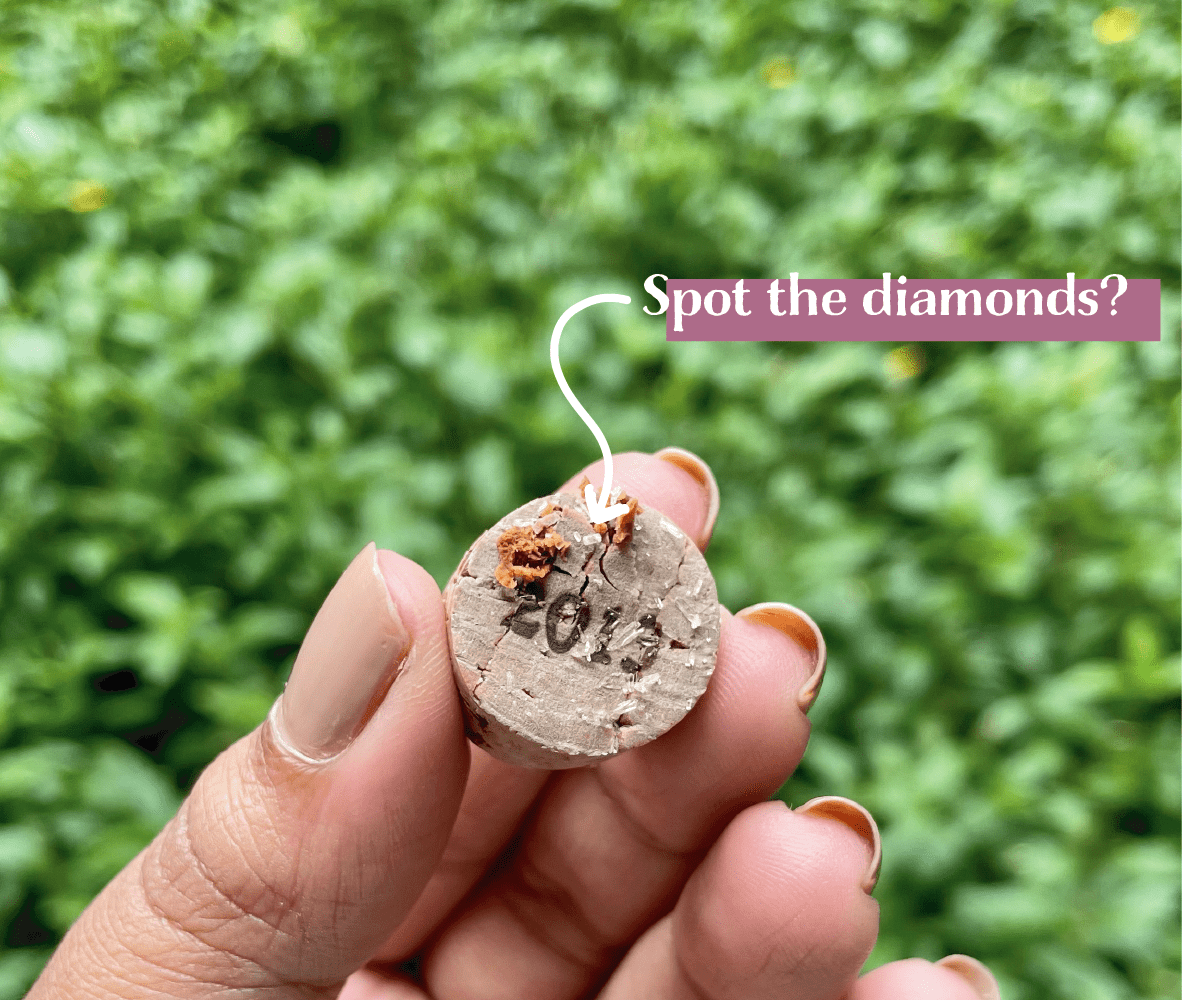Ever discovered any diamonds in your wine? Here’s what they really are.
Have you ever opened a terrific bottle of wine that you had been waiting to open for months or years, only to be confronted with tiny, glass crystal like particles stuck to the underside of the cork?
Here’s why you should be knowing about them…
By: Devati Mallick
Written for the DWD Blog, May 2022
Have you ever opened a terrific bottle of wine that you had been waiting to open for months or years, only to be confronted with tiny, glass crystal like particles stuck to the underside of the cork? At first glance, they appear to be tiny, broken diamond fragments, but heck, why is there glass in the wine? Well, don’t fret; I’m going to tell you that it’s actually not a big deal. These are harmless, and here’s why you should know about them…

What are these glass pieces?
This may sound scary at first, but it’s a common and acceptable phenomenon in wines, called tartrates, or fondly referred to as ‘wine diamonds’ by sommeliers. A light take on conveying that they mean no harm! Now that you’ve heard that there’s nothing to worry about these crystals, the reason behind why they occur is actually rather fascinating.
Tartrates in wine are a by-product of the winemaking process. We do know that wine grapes have a distinct ‘sour’ flavour, or acidity in them. Now, at the risk of sounding slightly technical, wine grapes have three different types of acidity in them (yikes!): tartaric, citric, and malic. Each kind has its own role in the winemaking process and is a hero in its own right, but we’re going to focus on our T-acid friend here causing all the chaos, tartaric acid, which is largely responsible for the tart acidity we taste in wines. Not only that, but it also helps wines keep their colour, maintain its chemical stability (think consistent pH levels), and keeps it from spoiling soon.
“Tartrates in wine are a by-product of the winemaking process, responsible for the tart acidity we taste in wines. It also helps wines keep their colour, maintain its chemical stability (think consistent pH levels), and keeps it from spoiling soon.”
Umm..how exactly does TA work?
Unlike malic acid, which is converted into a softer, lactic acid during the winemaking process, TA prefers to maintain its chemical composition, and the bulk of this acid remains soluble in the wine throughout- which means you won’t notice it. However, it does not always prefer to be this way and is quite sensitive to drastic temperature variations, which work like severe triggers for it.
Let’s say the wine had to go through some super freezing storages and other averagely chilled ones on its way to your glass from the winery—chances are the TA merely crystallised and fell out of its chemical composition. Or maybe you chilled the wine way more than it should have, TA will solidify and form the infamous crystals. These are the tiny solids you see stuck to the cork or floating at the bottom of the bottle.
So they’re harmless indeed to the wine’s flavour profile.
They can be found in both red and white wines, and once formed, tartrate crystals won’t go away—but rest assured, the wine’s aroma or flavour profile won’t be affected. If you still want them out of your wine because it doesn’t look particularly ‘clean’ or aesthetic, simply decant it with a filter or muslin cloth, removing the sediments or crystals from it.
To make it simpler, if you don’t see crystals in wine, which is almost always, it means the wine was kept at consistent temperatures, the TA is still present in the wine in soluble form, and you’re still drinking it. If it solidifies and forms crystals, you’re swallowing the exact same thing. Think of it like water and ice: same-same, but different, and totally harmless!
Many winemakers use a technique known as cold stabilisation to ensure clarity in their wines. This involves chilling the wine until it almost freezes for a couple of weeks. Completely done for aesthetic reasons, this drives the tartrate salts out of the wine’s composition, which is then separated from the wine before bottling. However, this treatment is frequently done for wines on the lower end of the price and quality spectrum, and many winemakers believe that cold stabilizing impacts the wine’s resulting flavour and ageability.
Therefore if you did catch a few ‘diamonds’ in your wine, it’s likely that the wine is of higher quality, or rather, one that hasn’t been altered or over-processed and has all of its natural, beautiful nuances intact.
We love our wine-flaws equally too, don’t we? (wink wink)
